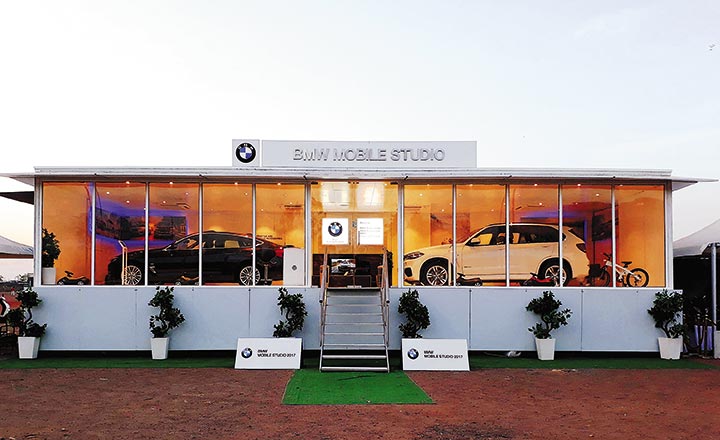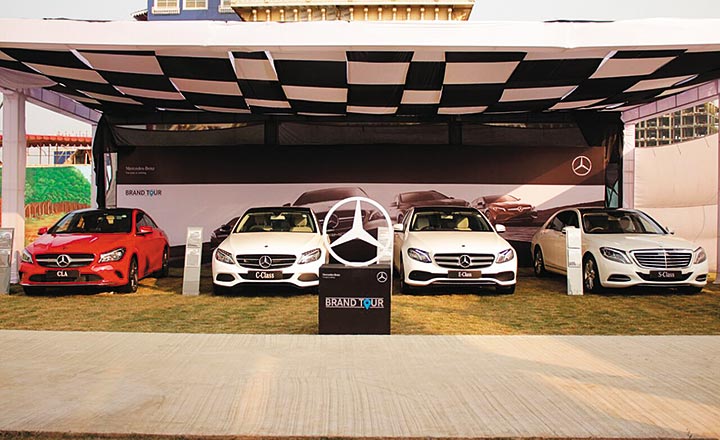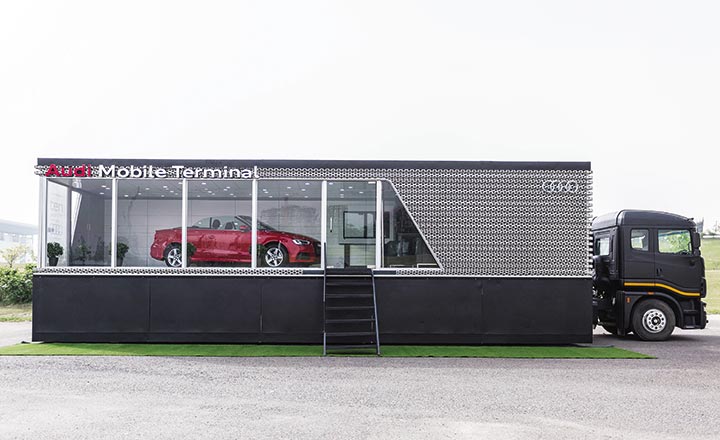From contemporary art to high street fashion and from exotic culinary experiences to golf tournaments — BMW has experimented with each of these themes at events for its clientele in the metros since its entry in the country in 2007. However, to make up for the stagnant sales in urban India, in the past couple of years, the German carmaker is making inroads into smaller cities. That explains its recent customer engagement activity at the Nizam’s Palace in Lucknow and the Lake Palace in Udaipur, where existing and prospective customers relished a scrumptious meal prepared by Michelin-starred chefs.
“It was a unique experience that we created for our customers. And the attendance in these smaller cities was phenomenal,” says Vikram Pahwa, president, BMW Group India, who further adds that skipping the tier-II and tier-III cities isn’t an option anymore. The premium automaker has competition close on its heels. Mercedes-Benz, which enjoys the title of being the top luxury carmaker due to its market share, kickstarted a Brand Tour in October, 2017 from Jalgaon in Maharashtra and covered 12 cities including Agra, Salem, Kottayam, Shillong, Rajahmundry, Jodhpur and Kolhapur by December.
Roland Folger, CEO, Mercedes-Benz India says, “The Brand Tour is crafted to extend our growing footprint to the untapped tier-II and tier-III emerging markets that do not have easy access to a Mercedes-Benz showroom.” It became the first of the three German luxury carmakers to set up base in India back in 1994. Audi, owned by Volkswagen and BMW followed much later in 2007. A 30% drop in sales in 2016 meant BMW overtook Audi to become the second largest car manufacturer in the country selling 7,861 vehicles. Jaguar Land Rover came in at a distant fourth position selling 2,400 cars in 2016.
Rajeev Singh, senior director, Deloitte India (automotive consultant) explains why luxury carmakers have developed this renewed focus on smaller towns, “They have realised that the tier-II and tier-III towns offer great growth potential which they can tap into. First, you saw the mass models making their way into emerging towns then it was premium cars, now it is the turn of the luxury car. Despite the lower volumes, there is definitely an opportunity there.”
Speaking of opportunities, Audi not being one to stay behind, has chalked out its own strategy to pursue the emerging town luxury car convert. Rahil Ansari, head, Audi India, explains why this market is important to the brand, “In 2017, about 25% of cars in the luxury category were sold in these cities.” In 2016, around 33,000 luxury cars were sold making up for around 1% of India’s passenger car market. In the past couple of years, the regulatory ban on diesel vehicles in the NCR region, slower economic growth and demonetisation contributed to the sluggish demand in this segment.
However, luxury car manufacturers have made a comeback of sorts in 2017 after a marginal decline in 2016. According to IHS Markit, the premium auto players are expected to sell 36,770 cars clocking a growth rate of 10.50%. This is the first time this segment is seeing a double-digit growth since 2012. There’s more good news in store for them as per the forecast of the market research firm that expects luxury car sales to increase in the next couple of years clocking growth rates of 42% and 21% in 2018 and 2019, respectively.

New direction
Luxury carmakers didn’t always have the emerging towns in mind when they wanted to raise their sales figures. When BMW set up shop in India back in 2007, Pahwa recalls only 2,000 luxury cars being sold. In order to change this, the brand established a dealer network in the metros. “Once we did that we saw that not just the income levels but also the aspirations were rapidly changing in tier-II towns. So in 2011-12, we began expanding into these markets,” he says. A decade ago, the brand that had nine dealerships, today, has about 42 showrooms across 31 cities.
Among the luxury car manufacturers in India, BMW was the fastest growing brand clocking a sales growth of 14% in 2016. The carmaker that managed to sustain the good run with 17.3% growth in the first nine months of 2017 and has a two-pronged approach to increase its presence among customers in emerging towns. First, is the traditional route of expanding the dealer network. The company plans to expand its showroom network to 50 by end of 2019. “A majority of them will come up in emerging towns. Last month, we opened a new facility in Madurai. A couple of weeks before that we had opened showrooms in Ranchi and Aurangabad,” informs Pahwa. Second, it launched mobile showrooms, called the BMW Studio, featuring a two-car display, a lifestyle collection and a VIP longue.
Stationed at premier locations such as five star hotels and large malls, this studio travels across the country and especially to smaller towns and cities. “Customers can experience the product and interact with our people as well. You get the same experience, touch and feel as you would in a traditional showroom,” Pahwa describes. The BMW Studio has travelled to 50 cities including places such as Agra, Varanasi, Salem, Jalandhar, Visakhapatnam, Tirunelveli and Jabalpur.
Audi and Mercedes too have their own version of a showroom-on-wheels. While Audi calls it The Mobile Terminal, Mercedes calls it The Brand Tour. Audi finds that the mobile showroom format fits well with its brand positioning. “We want to be desirable but approachable at the same time. And Audi Mobile Terminals make us approachable,” says Ansari. Audi released the first such mobile terminal one in 2015 and has covered 80 cities so far that include Jodhpur, Hubli, Ambala, Hisar, Muzaffarnagar, Saharanpur, Meerut, Aligarh, Agra and Amritsar. Audi, which reached the top spot within five years of its foray into the Indian market in 2012, is looking to regain its lost glory with a flurry of new launches and the Mobile Terminal.
Typically, all three companies offer test drives, booking services, and even financing and insurance schemes through such platforms. The mobile showroom enables these luxury automakers to increase their reach across the country without incurring the risk and high cost of setting up a permanent dealership. Typically, building up a traditional showroom would cost between Rs.25 crore-Rs.30 crore while a mobile showroom comes at a fraction of that price (around 5-10%).

Covering all the bases
Apart from just expanding into smaller towns, the brands are cognisant of the need for after-sales service and maintenance. Especially for a luxury car owner, who invests a significant amount and expects a lot in return. Audi has a distinct strategy to assuage any such inhibitions on part of its customers, “We have identified cities where we would come up with workshops first. We are doing this because it gives customers an assurance that they are in close proximity to an Audi workshop,” says Ansari.
Deloitte’s Singh is of the opinion that this would work really well for the brand. “If you are not setting up a conventional outlet, then how do you create a business case for a dealer in terms of profitability? The advantage of the workshop-first strategy is that if you have a large dealer in a 250-km radius, he can set up a service outlet. His catchment area goes up. It’s a carrot for the dealer as well,” he says.
BMW has a different approach to address the servicing and maintenance requirement. “We organise service camps in 50 towns that our BMW Studios travel to with the help of our nearest dealer. Buyers in these towns personally like to visit our workshops for servicing. If the workshop and showroom are at the same place, it gives us an opportunity to showcase not only our new products but the entire range as well.”
That’s not all though, the carmakers have also factored in the cost bit and have introduced financing and buy-back schemes for customers in these regions. “A lot of these clients are venturing into the luxury segment for the first time. They are usually concerned about financing and maintenance costs and resale value. So, we have a product called BMW 360 degree programme to cater to all their needs,” Pahwa says.
Under this initiative, customers select the model of their choice and the tenure of their financial contract based on their per annum mileage requirement. They pay a monthly fee to cover the financing and servicing costs besides getting an extended warranty for three years. At the end of this period, it also comes with an assured buyback value. So the customer can return the vehicle at the end of three years or complete the down payment and take possession of the car or trade it in for a higher model. “The purchase decision becomes easy because they know what their outflow is for the next three years,” Pahwa explains.

According to him, fundamentally, there is not a lot of difference between a luxury car buyer from a metro and a smaller town. Their profiles may be different. One could be a big-city lawyer and the other a businessman in a smaller town. “Both of them are equally demanding. Understandably, thanks to the Internet being the leveler, the customers in tier-II and III towns are very well informed today. They know exactly what they want,” says Audi’s Ansari.
And the auto brands have used this high-level of product awareness and customer’s online research data to their advantage. “When we had to decide the locations to set up our BMW Studio, we turned to social media to find out where people were looking for us, either discussing or enquiring about our showrooms. That’s how we chose the location for our studio in tier-II and tier-III towns,” BMW’s Pahwa adds.
While it accounts for a mere 1% in India, luxury cars make up for 5-6% of passenger car sales in developed markets. By 2020, analysts predict that the Indian passenger car industry will increase from its current size of 3 million vehicles to more than 5 million cars by 2020 and they expect the luxury car segment to account for 2-3% of that market. This forecast explains the exuberant future plans of luxury carmakers. All of them are looking to launch more models in the next one year with deeper localisation, wherein more cars are manufactured in India. With newer markets opening up and aspiration levels rising in sync with purchasing power, things are only set to get bigger and better for luxury car brands.











